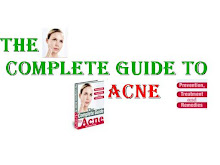Mild to severe forms of Acne appears on the skin. The different types of Acne Vulgaris infection that appears on the skin is characterized by the specific lesions as follows:
1) White Heads:
White Head is a non-inflammatory type of acne lesion. It is medically called as Closed Comedo. The basic acne lesion called as comedo is an enlarged and plugged hair follicle which contains trapped sebum, bacteria, and dead skin cells. When this comedo is completely blocked, the contents of the comedo stays beneath the skin surface and produces white bump called a Whitehead as it looks white on the skin's surface. Whiteheads have a shorter life span than blackheads. View complete infomation on how to treat white heads.
2) Black Heads:
Black Head is a non-inflammatory type of acne lesion. It is medically called as Open Comedo. The basic acne lesion called as comedo is an enlarged and plugged hair follicle which contains trapped sebum, bacteria, and dead skin cells. When this comedo is partially blocked, the contents of the comedo slowly drain and reach the surface of the skin and opens up which is called a Blackhead as it looks black on the skin's surface. The black color that appears is not caused by dirt but it is due to the oxidation of skin's pigment, Melanin with oxygen in the air. Blackhead is a firmer structure and takes a very long time to clear as the contents drains very slowly to the surface of the skin. View complete information on how to treat Black heads.
3) Papule:
A papule is an inflamed lesion that appears as small, red, tender bumps without head. It does not contain pus which distinguishes them from pustules. Papules occur due to the breakage in the follicle wall and thus allowing the bacteria to enter in the dermis. It is important to avoid squeezing of the papule as it leads to scarring. View complete information on how to treat Papule.
4) Pustule:
A pustule is an inflamed lesion that appears as pus filled white or yellowish center surrounded by a red base. Sometimes the pus head shows the brown comedonal core cap on the top. The pustule ranges in size from small to fairly large. Do not prick a pustule but if it’s harassing you then just read steps of how to squeeze a pimple before you prick it. View complete information on how to treat Pustule.
5) Nodule:
A nodule is a severe form of acne lesion. Nodules are large, hard, solid, painful inflamed bumps that occur deep within the skin. Nodule lesion lasts for a long time. Scarring is common. A nodule occurs when the follicle wall ruptures deep within the dermis. The bacteria and other debris flows out in the dermis and infect the adjoining follicles. Never squeeze such a lesion because by doing so it may rupture more follicles and the lesion may take a longer time to clear than it normally requires. View complete information on how to treat Nodules.
6) Cyst:
A Cyst is the most severe form of acne lesion that is similar in appearance to a nodule. Cysts are pus filled large, highly painful inflamed bumps with a diameter of 2 inches that occur deep within the skin. Cystic lesion lasts for a long time. It carries the biggest treat of Scarring. A cyst occurs when the follicle wall ruptures deep within the dermis and the pus burst into the skin tissue. The body’s immune system sends white blood cells to the site of infection to fight against the bacteria which results in swelling and pain. Never squeeze such a lesion because by doing so the cyst can cause a deeper and painful infection. View complete information on how to treat Cyst.

1 comment:
Acne generally happens at the young age children and teenagers. Acne, zits, spots and pimples can only be cured if the patients follow acne care tips. Natural treatment oil i.e. tea tree oil give complete relief from fungal infections such as warts and sores.
http://www.treatmentsforacne.net/
Post a Comment